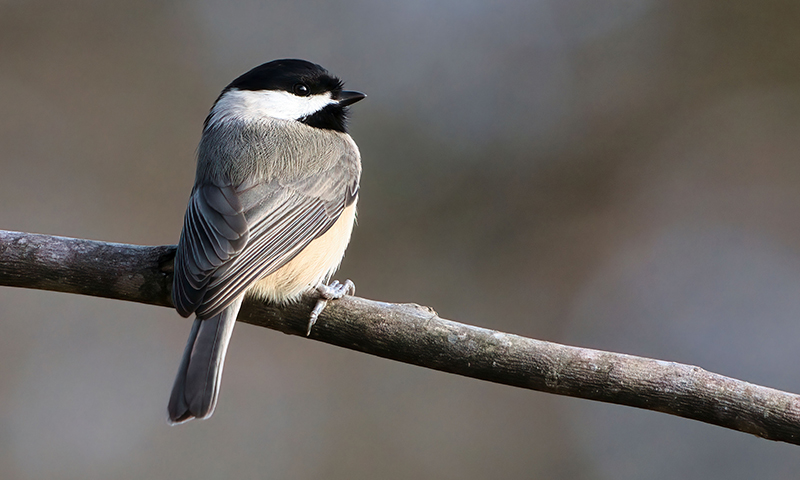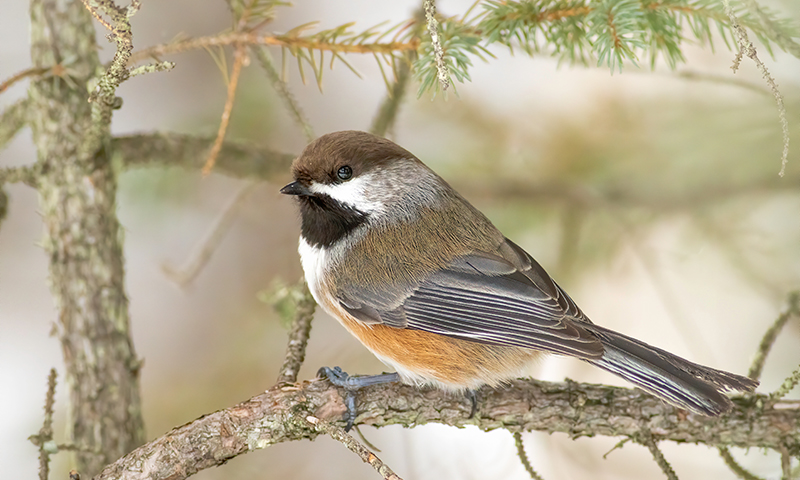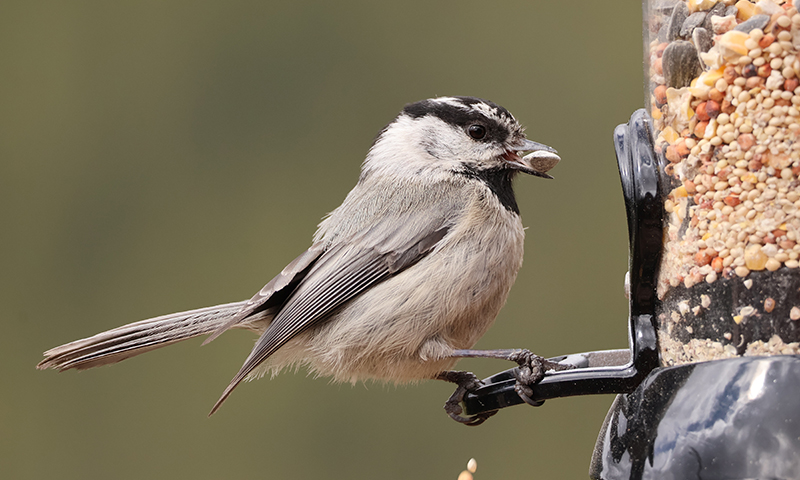All About Chickadees and How to Attract Them
The petite little chickadee loves attention. After all, it sings its name out loud and clear so bird watchers can get a good glimpse.
Chicka dee dee dee dee dee
Chicka dee dee dee dee dee
But did you know this wild bird changes the length of its tune based on nervousness? The call helps warn other birds of potential predators in the area. The more "dees" you hear after the "chicka," the higher the alert level.
To learn more about these songbirds, we chatted with Maren Gimpel, associate director of Foreman's Branch Bird Observatory at Washington College in Maryland. She's also a certified bird bander and bird banding trainer with the North American Banding Council.

Carolina chickadee
How to Identify a Chickadee
All chickadees appear small in size (4 to 6 inches long) with thin tails, black throat patches, white cheeks, and gray wings. Some have light brown flanks and backs or dark mask-like eye stripes, such as the Mountain chickadee.
If you don't see a chickadee, you'll likely hear it!
"While different chickadee species sound superficially like each other, it's best to check range maps for which species are in your area and then listen to their songs and calls online to learn what to listen for," Gimpel explained.
You can see pictures and listen to a variety of chickadee calls, including the Mexican, Mountain, Gray-headed, Chestnut-backed, Carolina, Boreal, and Black-capped, on the Cornell Lab All About Birds website.
Where to Find Chickadees in Nature
As part of the genus Poecile, chickadees primarily inhabit North America and Europe. Chickadees tend to stay in their general areas year-round. Some, however, will migrate based on food availability.
-
Mexican chickadee: The rarest of the bunch, you'll find Mexican chickadees in Mexico, Arizona, and New Mexico.
-
Carolina chickadee: This bird lives in the southeastern United States.
-
Black-capped chickadee: Folks living in the northeast part of the US get to enjoy Black-capped chickadees.
-
Boreal chickadees: From the northern parts of the US to all across Canada, you'll find the Boreal chickadee.
-
Mountain chickadees: These birds are found in the western parts of the US and into Canada.
-
Chestnut-backed chickadees: You can spot these pretty birds along the west coast into the Pacific Northwest, British Columbia, and Alaska.
When watching for chickadees, look closely, Gimpel advises. "It can get tricky, though, as Black-capped chickadees are also found in the western US and Canada and can be confused with Mountain chickadees. And, species of chickadees can mate with each other, creating hybrid offspring!"
Furthermore, chickadees often fly with other bird species, creating a mixed flock. You might just see chickadees alongside nuthatches, warblers, woodpeckers, and vireos.

Boreal chickadee
How to Bring Chickadees to Your Backyard
Chickadees love various locations. This means you can attract them to a suburban yard or spot them on a nature walk in a forest.
To bring them to your backyard, consider adding a bird nesting box to a pole or tree with an entrance hole approximately 1 1/8" in diameter (so larger birds don't try to move in). Gimpel suggests visiting the Cornell University Nestwatch website to learn how to build your own nesting box.
Parent birds only feed their young invertebrates (with caterpillars at the top of the menu). So, planting flowers or trees that encourage these critters also attracts chickadees.
"Dr. Doug Tallamy of the University of Delaware has done extensive research on the importance of native plants in sustaining chickadee populations. Native trees, such as oaks, host a much higher number of caterpillars. And since chickadees feed their young a diet of mostly caterpillars, a native oak tree provides substantially more natural 'bird food' than many other ornamental plants," Gimpel shared. "Dr. Tallamy estimates a pair of chickadees needs to find between 6,000 to 9,000 caterpillars to successfully fledge a clutch of chicks! Check online or at your local garden center for recommendations about what species are best suited to your area."

Mountain chickadee
Feeding Chickadees in Your Backyard
If you notice chickadees around your home or have recently inhabited nesting boxes, it's time to offer the adults food. Chickadees dine on a variety of small seeds and will happily explore larger sunflower seeds, even though it takes them a bit of work to open the shells.
Consider filling a Kaytee Cedar Seed And Suet Feeder with the following loose seed blends and seed cake options to attract chickadees to your backyard.
-
Kaytee Birders' Paradise: This well-loved wild bird mix featuring sunflower seed, millet, wheat, and more will not only bring chickadees to your feeder but also blue jays, goldfinches, titmice, nuthatches, and more.
-
Kaytee Gourmet Seed Cake: Slide this cake into a suet holder so your backyard friends can enjoy an assortment of peanuts, safflower, millet, sunflower seeds, and more.
-
Kaytee Ultra Wild Finch Sock: Don't let the name fool you — finches, as well as chickadees, juncos, and siskins, will enjoy the Nyjer® seed, sunflower chips, millet, and peanut hearts in this soft mesh sock. Simply hang it from your feeder, on a tree branch, or shepherd's hook.
-
Kaytee Mealworm Cake: This high-protein mix of seeds and dried mealworms will attract chickadees, bluebirds, robins, woodpeckers, and more to your bird feeder.
Having Fun With Chickadees
Since most chickadees don't migrate, you can enjoy their presence year-round once you've attracted them to your yard.
Gimpel says the longest-living chickadee recorded thus far by the United States Bird Banding Laboratory has celebrated at least eleven birthdays. Cheers to these longtime backyard friends!
As you grow your bird-watching hobby, consider browsing all the wild bird products from Kaytee, from feeders and baths to seed blends, seed cakes, and suet.
